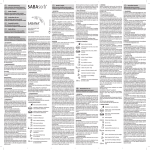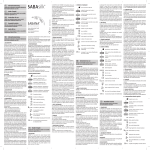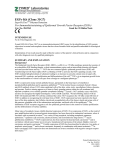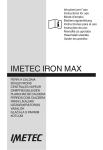Download © Mode d`emploi GB Instructions for use H Használati utasítás
Transcript
D L’emballage de SABApol® est bleu foncé. SABApol® remplit les exigences sévères de la pharmacopée européenne et de la directive CE 93/42/CEE concernant les dispositifs médicaux. Gebrauchsanweisung Steriles nicht-resorbierbares chirurgisches Nahtmaterial Nadel-Faden-Kombination aus Polypropylen F Mode d’emploi D Gebrauchsanweisung Steriles nicht-resorbierbares chirurgisches Nahtmaterial Nadel-Faden-Kombination aus Polypropylen 1. BESCHREIBUNG SABApol® ist ein nicht-resorbierbares steriles monofiles chirurgisches Nahtmaterial, das durch Polymerisation von Propylen hergestellt wird. Der Faden ist hydrophob, hat also praktisch keine Wasseradsorption. Er zeichnet sich insbesondere durch die isotaktische Eigenschaft des Fadens aus. Da er eine glatte, porenfreie Oberfläche besitzt, gleitet er beim Nähen sauber und gleichmäßig durch das Gewebe. Polypropylen wird nicht hydrolytisch abgebaut und ist daher besonders für versenkte und dauerhafte Nähte geeignet. SABApol® Nahtmaterial ist ungefärbt oder mit physiologisch unbedenklichem Farbstoff blau eingefärbt lieferbar. Es ist in verschiedenen Fadenstärken und -längen mit fest armierten chirurgischen Nadeln unterschiedlicher Typen und Durchmesser erhältlich. Die Verpackung von SABApol® ist dunkelblau gekennzeichnet. SABApol® erfüllt die strengen Anforderungen des Europäischen Arzneimittelbuchs und der EG-Richtlinie 93/42/EWG über Medizinprodukte. 2. ANWENDUNGSGEBIETE SABApol® ist vorgesehen für die Adaptation von Weichgewebe und/oder Ligatur, einschließlich der Ophthalmologie. Stand: 03/2012 Sabana Medizinbedarf GmbH Alwinenstraße 2 65189 Wiesbaden/Germany www.sabana.de Nadelspitzenbereich kann die Penetrationswirkung beeinträchtigen und zum Bruch der Nadel führen. Gleiches gilt für das Fassen der Nadel am armierten Ende. Vorsicht auch vor Nadelstichverletzungen! Gebrauchte Nadeln sind sofort nach der Benutzung in einen geeigneten durchstichsicheren Behälter zu entsorgen. 5. NEBENWIRKUNGEN Unerwünschte Nebenwirkungen bei der Anwendung von SABApol® können als anfängliche entzündliche Gewebereaktion oder als vorübergehende Irritation in der Wundregion auftreten. Wie alle Fremdkörper kann das Nahtmaterial eine vorhandene Infektion verstärken. 6. STERILITÄT SABApol® Nadel-Faden-Kombinationen sind mit Ethylenoxid sterilisiert. Es ist nicht zulässig, SABApol® zu resterilisieren! Das Produkt darf keinesfalls verwendet werden, wenn die Sterilverpackung beschädigt oder geöffnet ist. Geöffnete, nicht benutzte Produkte unbedingt entsorgen. 7. LAGERBEDINGUNGEN SABApol darf nur bei Temperaturen von unter 25° Celsius und geschützt vor Feuchtigkeit und direkter Hitzeeinwirkung gelagert werden. Nur in der Originalverpackung aufbewahren. Nach Ablauf des Verfallsdatums nicht mehr verwenden. ® 8. KENNZEICHNUNGSSYMBOLE Anwendung Das zu verwendende Nahtmaterial ist unter Berücksichtigung des Zustands des Patienten und der Größe der Wunde auszuwählen. Name und Anschrift des Herstellers gefärbtes, monofiles, nicht-resorbierbares Nahtmaterial Materialverhalten SABApol® löst eine anfängliche minimale entzündliche Gewebereaktion aus, worauf eine schrittweise Umschließung durch faseriges Bindegewebe eintritt. Es wird weder resorbiert noch unterliegt es einer Degradation oder Schwächung durch das Einwirken von Gewebeenzymen. Da es biologisch relativ inert ist, eignet es sich besonders, wenn eine möglichst geringe Gewebereaktion erwünscht ist. Als Monofilament wird es besonders bei solchen Wunden erfolgreich verwendet, die sich in der Folge kontaminieren oder infizieren können. Das Risiko der Bildung von Wundhöhlen und der Nahtabstoßung kann so auf ein Minimum reduziert werden. ungefärbtes, monofiles, nicht-resorbierbares Nahtmaterial Chargenbezeichnung Sterilisiert mit Ethylenoxid Nicht zur Wiederverwendung Nicht erneut sterilisieren Gebrauchsanweisung beachten 3. GEGENANZEIGEN SABApol® ist nicht bestimmt für Anwendung am Herz, am zentralen Kreislaufsystem oder am zentralen Nervensystem. J J JJ-MM Verwendbar bis (Jahr-Monat) Vor Sonnenlicht geschützt aufbewahren 4. WARNHINWEISE SABApol® ist zum einmaligen Gebrauch bestimmt. Die Nadeln dürfen keinesfalls resterilisiert werden. Die erneute Verwendung kann zu schweren, unter Umständen sogar tödlichen Infektionen des Patienten führen. Entsprechend den gesetzlichen Bestimmungen übernimmt der Hersteller hierfür keine Verantwortung. SABApol® darf nicht verwendet werden, • wenn das Verfallsdatum überschritten ist, • die Sterilverpackung beschädigt ist oder • Zweifel an ihrer Unversehrtheit bestehen. SABApol® darf nur von Ärzten angewendet werden, die mit der Anwendung von nicht-resorbierbarem Nahtmaterial vertraut sind, da das Risiko einer Wunddehiszenz vom Anwendungsort und vom verwendeten Nahtmaterial abhängt. Darüber hinaus muss der Operateur auch über ausreichende Kenntnisse über das notwendige Handling (z. B. Knotentechniken) verfügen. Der Operateur ist für Komplikationen verantwortlich, die sich aus einer fehlerhaften Indikation, einer unzureichenden Operationstechnik oder einem aseptischen Fehler ergeben. In allen Fällen wird empfohlen, den Eingriff durch entsprechende Nachsorgemaßnahmen zu begleiten. Wie jeder Fremdkörper kann ein längerer Kontakt mit Salzlösungen, wie sie etwa im Harn- und Gallentrakt vorkommen, zur Bildung von Konkrementen führen. Wie bei jedem anderen Nahtmaterial ist auch bei SABApol® darauf zu achten, dass es nicht durch falsche Handhabung beschädigt wird. So hinterlässt das Fassen mit einem Nadelhalter oder einer Klemme deutliche Spuren am Faden. Diese Schädigungen nehmen großen Einfluss auf die Reißfestigkeit eines Fadens. Auch die Handhabung der Nadel darf nur mit angemessener Vorsicht erfolgen. Die Nadel sollte immer am Anfang des letzten Drittels gefasst werden. Das Fassen der Nadel im 0123 Használati utasítás Materiale di sutura chirurgico sterile non riassorbibile Combinazione ago-filo in polipropilene Le matériel de suture à utiliser doit être choisi en fonction de l’état du patient et de la taille de la plaie. Instructions for use Guida all’uso matériel de suture non-teint, monofil, non-résorbable UTILISATION Steril nem felszívódó sebészeti varróanyag Tű-fonal kombináció polipropilén alapanyagból I matériel de suture teint, monofil, non-résorbable SABApol® est prévu pour l’adaptation et/ou la ligature de tissus mous, y compris en ophtalmologie. Sterile, non-absorbable surgical suture material Needle-suture combination made of polypropylene H Nom et adrese du fabricant 2. DOMAINES D’UTILISATION Matériel de suture chirurgical stérile non-résorbable Combinaison aiguille-fil en polypropylène 8. SYMBOLES DE MARQUAGE Obere Temperaturbegrenzung für die Lagerung Bei beschädigter Verpackung nicht verwenden 0123 CE-Kennzeichnung mit Kennnummer der Benannten Stelle F Mode d’emploi Matériel de suture chirurgical stérile non-résorbable Combinaison aiguille-fil en polypropylène 1. DESCRIPTION SABApol® est un matériel de suture chirurgical monofil stérile non-résorbable, fabriqué par polymérisation de propylène. Le fil est hydrophobe, il n’absorbe donc pas d’eau. Il se distingue en particulier par la propriété isotactique du fil. Comme il possède une surface lisse sans pores, il glisse proprement et régulièrement dans le tissu au moment de la suture. Le polypropylène n’est pas éliminé par hydrolyse et il est donc particulièrement bien adapté pour les coutures enfoncées et durables. Le matériel de suture SABApol® est disponible sous forme non-teinte ou teint en bleu avec un colorant inoffensif au niveau physiologique. Il est disponible en différentes grosseurs et longueurs de fil avec des aiguilles chirurgicales fixement armées de types et de diamètres différents. désignation du lot COMPORTEMENT DU MATERIAU SABApol® déclenche une réaction inflammatoire initiale minime du tissu, suivie d’un enrobage progressif par du tissu conjonctif fibreux. Il n’est pas résorbé et ne subit pas de dégradation ou de relâchement sous l’effet des enzymes des tissus. Comme il est relativement inerte au niveau biologique, il est particulièrement bien adapté, quand on souhaite obtenir une réaction la plus réduite possible du tissu. En qualité de monofilament, on l’utilise avec succès pour les plaies qui peuvent se contaminer ou s’infecter par la suite. Cela permet de réduire au minimum le risque de formation de cavités dans les plaies et de rejet de la suture. stérilisé à l’oxyde d’éthylène ne pas réutiliser ne pas stériliser à nouveau tenir compte du mode d’emploi JJJ J-MM à utiliser d’ici (année-mois) conserver à l’abri de la lumière du soleil 3. CONTRE-INDICATIONS SABApol® n’est pas fait pour une utilisation sur le cœur, l’appareil circulatoire central ou le système nerveux central. température maximale de stockage ne pas utiliser en cas d’emballage endommagé 4. MISES EN GARDE PARTICULIÈRES SABApol® est destiné à un usage unique. Il ne faut jamais restériliser les aiguilles. Une utilisation renouvelée peut entraîner de graves infections du patient, voire des infections mortelles. Conformément aux dispositions légales, le fabricant décline toute responsabilité à cet égard. Il ne faut pas utiliser SABApol® • quand la date de péremption est dépassée • quand l’emballage stérile est endommagé ou • s’il y a des doutes quant à l’intégralité de l’emballage. SABApol® ne peut être utilisé que par des médecins qui connaissent bien l’utilisation de matériel de suture nonrésorbable, puisque le risque de déhiscence de plaie dépend de l’endroit de l’utilisation et du matériel de suture utilisé. En outre, le chirurgien doit disposer de connaissances suffisantes sur la manipulation nécessaire (p.ex. techniques de nœuds). Le chirurgien est responsable des complications résultant d’une indication erronée, d’une technique opératoire insuffisante ou d’une erreur stérile. En tous cas, on recommande d’accompagner l’opération de mesures de suivi correspondantes. Comme tout corps étranger, un contact prolongé avec des solutions salées – comme c’est le cas dans les voies urinaires et les voies biliaires, peut entraîner la formation de concrétions. Dans l’utilisation de SABApol®, comme dans l’utilisation de tout autre matériel de suture, il faut également veiller à ne pas endommager le matériel par fausse manipulation. La saisie du fil avec un porte-aiguille ou une pince laisse des traces distinctes sur le fil. Ces dégradations ont une grande influence sur la résistance d’un fil à la rupture. Il faut également manier l’aiguille avec une précaution adaptée. C’est toujours uniquement au début du dernier tiers qu’il faut tenir l’aiguille. Quand on tient l’aiguille dans la zone de la pointe, cela peut altérer l’effet de pénétration et entraîner la rupture de l’aiguille. La même chose vaut pour la saisie de l’aiguille par le bout armé. Attention également aux blessures par piqûres d’aiguille! Après utilisation, il faut immédiatement éliminer les aiguilles usagées dans des contenants spéciaux destinés à recevoir les aiguilles et les objets pointus ou tranchants. 5. EFFETS SECONDAIRES Dans l’utilisation de SABApol®, les effets secondaires non souhaités peuvent consister en une réaction initiale d’inflammation du tissu ou en une irritation passagère dans la zone de la plaie. Comme tous les corps étranger, le matériel de suture peut aggraver une infection existante. 6. STÉRILITÉ Les combinaisons d’aiguille et de fil SABApol® sont stérilisées à l’oxyde d’éthylène. Il est interdit de restériliser SABApol®! Le produit ne peut en aucun cas être utilisé si l’emballage stérile est endommagé ou ouvert. Il faut absolument éliminer les produits ouverts non utilisés. 7. CONDITIONS DE STOCKAGE SABApol® doit être uniquement stocké à des températures de moins de 25° Celsius et il faut le protéger de l’humidité et de l’effet direct de la chaleur. A conserver uniquement dans l’emballage original. Ne plus utiliser après expiration de la date de péremption. 0123 marquage CE avec numéro d’identification du service accrédité handling. Thus, gripping it with a needle holder or a clamp leaves clear marks on the suture. Such damage has a strong influence on the stability of a suture. The needle must also be handled with the appropriate care. The needle should always be grasped at the beginning of the last third. Grasping the needle at its point can impair penetration and result in breakage of the needle. The same applies to grasping the needle at the swaged end. Caution must also be exercised with regard to puncture injuries from needles. Used needles must be disposed of in a suitable puncture-proof container immediately after use. 5. SIDE EFFECTS Adverse side effects from the use of SABApol® can consist of temporary tissue irritation or a temporary inflammatory reaction in the area of the wound. Like all foreign bodies, the suture material can aggravate an existing infection. 6. STERILITY SABApol® needle and suture combinations are sterilized with ethylene oxide. Resterilization of SABApol® is prohibited! The product must not be used if the sterile packaging is damaged or open. Always dispose of opened, unused products. 7. STORAGE CONDITIONS SABApol® must be stored only at temperatures below 25° Celsius and protected from moisture and heat. Store only in the original packaging! Do not use this product after the expiration date! 8. LABELING SYMBOLS Manufacturer’s name and address Dyed, monofilament, non-absorbable suture material Instructions for use Undyed, monofilament, non-absorbable suture material Sterile, non-absorbable surgical suture material Needle-suture combination made of polypropylene Batch designation 1. DESCRIPTION SABApol® is a synthetic, non-absorbable sterile monofilament surgical suture material manufactured via polymerization of propylene. The suture material is hydrophobic, so that practically no water is adsorbed. It is distinguished particularly by the isotactic property of the suture. Because it has a smooth, non-porous surface, it glides cleanly and evenly through the tissue during suturing. Polypropylene does not degrade hydrolytically and is therefore especially suitable for buried and permanent sutures. SABApol® suture material is available undyed or dyed blue with physiologically safe dye. It is available in different sizes and lengths with swaged surgical needles of various types and diameters. The packaging of SABApol® is marked in dark blue. SABApol® meets the strict requirements of the European Pharmacopoeia and the EC Directive 93/42/EEC on medical devices. 2. AREAS OF APPLICATION SABApol® is used for the adaptation of soft tissue and/or ligature, including use in ophthalmology. Sterilized with ethylene oxide Do not re-use. Do not resterilize. Comply with the instructions for use. JJJ J-MM Usable until (year-month) Store in a dark location away from sunlight. Upper temperature limit for storage Do not use if the packaging is damaged. 0123 CE mark with code number of the Notified Body APPLICATION The suture material to be used must be selected based on the condition of the patient and the size of the wound. MATERIAL BEHAVIOR SABApol® triggers an initial minimally inflammatory tissue response, followed by incremental envelopment in fibrous connective tissue. It is neither absorbed nor is it degraded or weakened by the action of enzymes in the tissue. Because it is biologically relatively inert, it is particularly suitable when a minimal tissue response is desired. As a monofilament it is used successfully especially for wounds that can later be contaminated or infected. Thus the risk of forming wound cavities and rejection of the sutures can be reduced to a minimum. 3. CONTRAINDICATIONS SABApol® is not intended for use in the heart, the central cardiovascular system or the central nervous system. 4. WARNINGS SABApol® is intended for single use only. The needles may not be resterilized under any circumstances. Re-use can lead to severe and possibly fatal infections in patients. In accordance with statutory provisions, the manufacturer is not liable for this. SABApol® may not be used • if the expiration date is in the past, • the sterile packaging is damaged or • if there is doubt as to whether it is intact. SABApol® may be used only by physicians who are familiar with the use of non-absorbable suture material, as the risk of wound dehiscence depends on the site where the sutures are used and on the suture material used. In addition, the surgeon must have sufficient knowledge of the handling required (e.g. knotting techniques). The surgeon is responsible for complications resulting from an incorrect indication, inadequate surgical techniques or an aseptic error. In all cases it is recommended that the surgery be accompanied by corresponding after-care measures. Like any foreign body, longer contact with saline solutions such as those in the urinary and biliary tracts, can result in the formation of concrements. As with any other suture material, care must be taken with SABApol® to ensure that it is not damaged by incorrect H Használati utasítás Steril nem felszívódó sebészeti varróanyag Tű-fonal kombináció polipropilén alapanyagból 1. TERMÉKLEÍRÁS A SABApol® propilén polimerizációjával előállított nem felszívódó, steril, monofil sebészeti varróanyag. A fonal hidrofób, azaz gyakorlatilag nem vesz fel vizet. Legfőbb jellemzője izotaktikus tulajdonságában rejlik. Mivel a fonal felülete sima és pórusmentes, a varráskor problémamentesen és egyenletesen halad át a szöveten. A polipropilén nem bomlik le hidrolízis során és ezáltal különösen alkalmas tovafutó és tartós varratok esetén. A SABApol® varróanyag színtelen vagy fiziológiailag ártalmatlan kék színezékanyaggal színezett kiszerelésben kapható. Különböző fonalvastagságban és -hosszban, valamint különböző típusú és átmérőjű, fixen a fonalhoz csatlakozó sebészeti tűvel felszerelve kerül forgalomba. A SABApol® csomagolása sötétkék jelölést visel. A SABApol® megfelel az Európai Gyógyszerkönyv és az orvostechnikai eszközökről szóló 93/42/EGK irányelv szigorú követelményeinek. 2. ALKALMAZÁSI TERÜLETEK A SABApol® lágy szövetek egyesítésére és/vagy lekötésére alkalmas, a szemészeti beavatozásokat is ideértve. ALKALMAZÁS A alkalmazott varróanyag kiválasztásakor a beteg állapotát és a seb méretét kell figyelembe venni. ANYAGVISELKEDÉS A SABApol® kezdetben minimális gyulladásos szövetreakciót idéz elő, amit a varróanyag fokozatos kötőszövetes betokozódása kísér. Nem szívódik fel, nem degradálódik, és szakítószilárdsága nem gyengül a szövetenzimek hatására. Mivel biológiailag relatív iners, különösen alkalmas minimális szövetreakciót megkívánó esetekben. A varróanyag egyetlen szálból készül, ezért alkalmazása olyan sebek esetén jár különös sikerrel, melyek kontaminálódhatnak vagy megfertőződhetnek a beavatkozás következtében. Ezáltal minimálisra csökkenthető a sebüregképződés és a varratkilődés kockázata. 3. ELLENJAVALLATOK A SABApol® nem alkalmazható a szíven, a központi keringési rendszeren és a központi idegrendszeren végzett beavatkozások során. 4. FIGYELMEZTETÉSEK A SABApol® egyszeri használatra szánt termék. A tűket tilos újrasterilizálni. Ezek újrafelhasználása súlyos, egyes esetekben akár halálos fertőzést is eredményezhet a betegben. A törvényes rendelkezések értelmében a gyártó ilyen esetekben nem vállal felelősséget. A SABApol® nem alkalmazható, ha • lejárt a felhasználási ideje, • nem ép a steril csomagolás vagy • kétség merül fel a csomagolás sértetlenségét illetően. A SABApol®-t csak a nem felszívódó varróanyagok alkalmazásában jártas orvosok használhatják, mert a varratelégtelenség kockázatának fellépése az alkalmazás helyétől és az alkalmazásra kerülő varróanyagtól függ. A sebésznek emellett megfelelő ismeretekkel kell rendelkeznie a sebészeti eljárások terén (pl. csomózási technikák). A helytelen indikációból, a nem megfelelő sebészeti technika alkalmazásából és az aszepszist gátló hibákból eredő szövődményekért a sebész a felelős. Minden egyes beavatkozás után tanácsos megfelelő utógondozásban részesíteni a beteget. A varrófonalak tartós érintkezése idegen anyaggal, így a húgyutak és az epeutak területén előforduló sóoldatokkal is, kőképződéshez vezethet. Mint minden egyéb varróanyagnál, úgy a SABApol® esetén is ügyelni kell arra, hogy az anyag ne károsodjon helytelen kezelés következtében. Ha a tűfogó vagy a csipesz érintkezik a fonallal, maradandó nyomot hagy hátra. Ezek a károsodások jelentősen befolyásolják a fonal szakítószilárdságát. A tűt is csak kellő óvatosság mellett szabad alkalmazni, és mindig az utolsó harmad kezdeténél kell megfogni. A tűhegy területének megragadása a penetrációs képesség csökkenését és a tű eltörését eredményezheti. Ugyanez történhet a tű fonalhoz csatlakozó végének megragadásakor is. Óvatosan kell eljárni a tűszúrás okozta sérülések elkerülése érdekében is. A használt tűt az alkalmazást követően haladéktalanul egy erre a célra alkalmas szúrásbiztos tartályba kell bedobni. 5. MELLÉKHATÁSOK A SABApol® alkalmazása során fellépő nemkívánatos mellékhatások a következők lehetnek: kezdeti gyulladásos szövetreakció, a sebkörnyék átmeneti irritációja. Mint minden idegen test, így a varróanyag is súlyosbíthatja a már fennálló fertőzéseket. 6. STERILITÁS A SABApol® tű-fonal kombináció sterilizálása etilén-oxiddal történik. A SABApol® újrasterilizálása tilos. Ha a steril csomagolás nem ép vagy nyitva van, a terméket nem szabad alkalmazni. A nyitott állapotú, fel nem használt terméket mindenképpen ki kell dobni. 7. TÁROLÁSI FELTÉTELEK A SABApol® csakis 25°C hőmérséklet alatt, nedvességtől és közvetlen hőhatástól védve tárolandó. Kizárólag az eredeti csomagolásban tartandó. A felhasználhatósági idő lejárta után nem szabad alkalmazni. 8. A CSOMAGOLÁSON HASZNÁLT JELÖLÉSEK A gyártó neve és címe színezett, monofil, nem felszívódó varróanyag színezetlen, monofil, nem felszívódó varróanyag Gyártási szám Etilén-oxiddal sterilizálva Egyszer használatos Nem szabad újrasterilizálni Vegye figyelembe a használati utasítást. JJJ J-MM Felhasználható: (év-hónap) Napfénytől védve tartandó. Maximális tárolási hőmérséklet Nem szadad alkalmazni, ha a csomagolás nem ép. 0123 CE-jelölés bevizsgálóhely azonosító számával I Guida all’uso Materiale di sutura chirurgico sterile non riassorbibile Combinazione ago-filo in polipropilene 1. DESCRIZIONE SABApol® è un materiale di sutura chirurgico non riassorbibile sterile monofilamento, ottenuto dalla polimerizzazione di propilene. Il filo è idrofobo, non presentando in pratica alcun assorbimento d’acqua, e si distingue in particolare per le proprietà isotattiche del filo. La superficie liscia esente da pori consente al filo di scorrere più facilmente e più uniformemente attraverso il tessuto. Il polipropilene non è soggetto a degradazione idrolitica e si presta pertanto particolarmente per suture profonde e a permanenza. Il materiale di sutura SABApol® è fornito non colorato o colorato con colorante blu fisiologicamente sicuro. È disponibile in fili di diverso spessore e lunghezza con aghi chirurgici saldamente armati di vario tipo e diametro. SABApol® si riconosce dalla confezione in colore blu scuro. SABApol® soddisfa i severi requisiti della Farmacopea Europea e della direttiva comunitaria 93/42/CEE sui prodotti medicali. 2. CAMPO DI IMPIEGO SABApol® è previsto per l’adattamento di tessuti molli e/o la legatura, inclusa l’oftalmologia. IMPIEGO Il materiale di sutura da utilizzare va scelto tenendo conto delle condizioni del paziente e delle dimensioni della ferita. COMPORTAMENTO DEL MATERIALE SABApol® causa una minima reazione infiammatoria iniziale nei tessuti, seguita da un graduale incapsulamento della sutura nel tessuto connettivo fibroso. Il materiale non viene riassorbito, né è soggetto a una degradazione o ad un rilassamento per effetto degli enzimi tissutali. Vista la sua inerzia biologica, è raccomandato in tutte le situazioni in cui si tende a contenere quanto più possibile una reazione tissutale. Nella versione monofilamento il materiale è utilizzato con successo in particolare in ferite esposte a una possibile contaminazione o infezione post-operatoria. In questo modo è possibile ridurre al minimo il rischio della formazione di cavità della ferita e il rigetto della sutura. 3. CONTROINDICAZIONI SABApol® non è destinato all’impiego sul cuore, sul sistema circolatorio centrale o sul sistema nervoso centrale. 4. AVVERTENZE SABApol® è destinato a essere usato una volta sola. Gli aghi non devono essere risterilizzati in nessun caso. Il riutilizzo può portare a gravi infezioni nel paziente, persino letali in alcune circostanze. Conformemente alle disposizioni di legge, il produttore non assume alcuna responsabilità a questo riguardo. SABApol® non deve essere utilizzato quando: • si è superata la data di scadenza, • la confezione sterile è lesionata oppure • ci sono dubbi sulla sua integrità. SABApol® può essere impiegato solo da medici che hanno confidenza con l’utilizzo di materiale di sutura non riassorbibile, in quanto il rischio di una deiscenza della ferita dipende dal punto di applicazione e dal materiale di sutura utilizzato. Oltre a ciò, l’operatore deve anche disporre di sufficienti conoscenze in merito al trattamento necessario (le tecniche dei nodi, per esempio). L’operatore è responsabile di complicazioni risultanti da un’errata indicazione, una insufficiente tecnica operatoria o un errore asettico. Si raccomanda in tutti i casi di accompagnare l’intervento con una corrispondente assistenza post-operatoria. Come ogni corpo estraneo, un contatto prolungato con soluzioni saline, quali si presentano ad esempio nel tratto urinario e biliare, può portare alla formazione di concrementi. Come con ogni altro materiale di sutura, anche con SABApol® si deve aver cura di non danneggiarlo con un’errata manipolazione. Afferrarlo quindi con un porta-aghi o una graffetta lascia tracce evidenti sul filo. Questi danni hanno una grande influenza sulla resistenza allo strappo di un filo. Anche il maneggio dell’ago deve avvenire solo con adeguata cautela. L’ago andrebbe sempre afferrato all’inizio dell’ultimo terzo. Afferrare l’ago nella regione della punta può compromettere l’azione di penetrazione e portare alla rottura dell’ago. Lo stesso vale prendendo l’ago sull’estremità armata. Attenzione anche a non ferirsi pungendosi con l’ago! Gli aghi usati vanno subito smaltiti dopo l’uso in un opportuno contenitore non perforabile. 5. EFFETTI COLLATERALI Effetti collaterali indesiderati nell’impiego di SABApol® possono presentarsi come una reazione tissutale infiammatoria iniziale o una passeggera irritazione nella regione della ferita. Come tutti i corpi estranei, il materiale di sutura può acuire una infezione in atto. 6. STERILITÀ Le combinazioni ago-filo SABApol® sono sterilizzate con ossido di etilene. Non è consentito risterilizzare SABApol®! Il prodotto non deve in nessun caso essere utilizzato quando la confezione sterile è danneggiata o aperta. Smaltire assolutamente i prodotti aperti non utilizzati. 7. CONDIZIONI DI CONSERVAZIONE SABApol® può essere conservato solo a temperature inferiori a 25° Celsius e al riparo da umidità ed azione diretta del calore. Conservare solo nella confezione originale. Non utilizzare più superata la data di scadenza. 8. SIMBOLI IDENTIFICATIVI Nome e indirizzo del produttore Materiale di sutura colorato monofilamento non riassorbibile Materiale di sutura non colorato monofilamento non riassorbibile Identificazione del lotto Sterilizzato con ossido di etilene Da non riutilizzare Da non sterilizzare di nuovo Osservare la guida all’uso J J JJ-MM Utilizzabile entro (anno-mese) Conservare al riparo dalla luce solare Limite massimo di temperatura per la conservazione Non utilizzare in caso di confezione danneggiata Marchio CE con numero identificativo 0123 dell’Organismo Notificato









